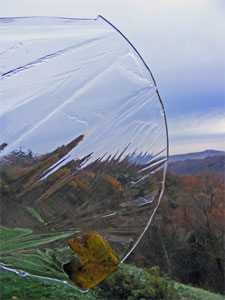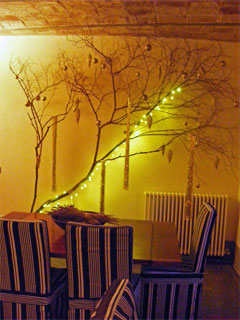CdP
11 December 2010

I spent hours a couple of months ago, collating wisdom from various sources to draw up a foolproof organic treatment schedule (below) which would lead to a summer of fruit which was actually edible, rather than a tasty but exhausting carving exercise to remove the many creatures in merrily munching competition.
I’m weeks behind already though, and wondering when I’ll ever catch up. Or indeed if I really need all these wonderful cures that I’m planning to give my poor unsuspecting little trees. Then again, the chances of my actually sticking to my programme are slim.
I have put a proper sprayer for this on my letter to Father Christmas. The one that I have now is mediumly all right, as long as you’ve only got a couple of rose bushes to squirt. But after hours and hours pumping away at it yesterday, turning fruit trees and roses a lovely shade of blue, both my arms feel like they’ve been pummelled by a boxer. And my left shoulder – the one I tend to use for working the pump – is more or less paralized.
The brief time I managed to devote to the garden this afternoon (the morning zipped away searching but not finding the perfect chainsaw for L for Christmas: our Christmas lists are remarkably unromantic) I spent dismantling my summer vegetable garden pergola. It was such an ambitious one this year, that the whole area looks terribly naked without the huge frame of canes.
Our Arundo donax cane is not only the bane of my life, as it comes creeping with its immense rhizome roots into places where I absolutely don’t want it: it’s also of only relative usefulness in that yes, you can use it as supports for all kinds of things but for one season, max. After which it just crumbles and cracks and generally turns black and falls to pieces. At least this means, however, that I get to redesign my vegetable garden each year – always the same, always different.
Heavens, who would have thought? I just did some research and found I have absolutely no right to loath Arundo with the intensity I do. It’s one of the best possible sources of biomass for biofuel (I wonder if I can find someone who’d like to come and harvest all ours on a regular basis) and it’s also remarkably efficicent in carbon sequestration, above and below ground. And it’s great for phytoremediation of polluted or saline soils. Hmmmm. I’m trying to make this make me look more favourably on the inexorably creeping stuff. I’m have some difficulty though.
How do you stop such a massive gulley slipping away? Well, if we were sensible and had the correct equipment, we would get out with our tractor (which we don’t have) each autumn and plough a deep furrow right around the field, offset a few metres in from the bottom edges, so that the rainwater flowed down the field, into that, then was channeled purposefully into one or two well behaved outlets over the edge. That’s what the farmers used to do. In fact, it’s what the few remaining farmers still do. But managing to get someone in to do that for you right at the time when all useful hands are picking olives is no easy thing. And if I found anyone now, their tractor would just sink straight into the mire down there.
Then the whole exposed bank should be planted with tiny saplings – willow’s a good one, if there’s enough water – and left to reestablish itself. But I’m sure won’t get around to that either… even if I could afford it. Anyway, planting on what is now a sheer cliff face would be no joke: much major earth-movement would probably be required before anything could be done, and that’s really out of the question. It’s funny to think that our whole, chiselled-away valley was formed like that. And that probably our house was once much further from the edge that it is now. And that one day it will probably be right on the edge. But I don’t think that will be for quite a long time to come. At least, I hope not.

WHAT
Lime sulphur
Dormant oil (Olio minerale)
Bordeaux mix
Dolomite lime
Copper sulphate
Sulphur
Bacillus thuringiensis (BT)
Bordeaux mix
Pyrethrum
BT
Pyrethrum
Bordeaux mix
Bordeaux mix
Sulphur
Dec/Jan
Early spring - before buds open
Spring (March)
Spring (or autumn), dusting on ground
Before leaves sprout
Pre-bloom
Between petal fall and beginning of June (2x)
Post-bloom (2x, 2wks apart)
Every 10 days thru' June
Beginning, mid July
Every 10 days thru' Aug
Sept, after harvest
Nov, after leaf fall
After leaf fall
Peach curl
Over-wintering insect eggs
Canker (peach, plum, cherry)
Disease, brings calcium & magnesium
Scab, Peach curl, mildew, scab (apples, pears)
Caterpillar larvae
Scab (apples, pears)
Peach curl, canker (apples, pears)
Peach curl, canker (peach, plum, cherry)
Scab (apples, pears)